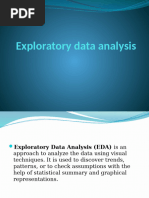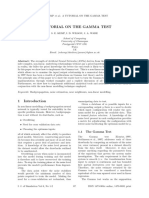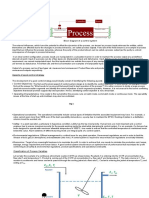0 ratings0% found this document useful (0 votes)
70 viewsUse Plotly
This document discusses using ggplotly() to convert ggplot2 graphs to interactive plotly graphs. It provides examples converting a hexbin plot of diamond carat versus price, frequency polygons of diamond price by clarity, and frequency polygons faceted by cut. ggplotly() allows leveraging ggplot2's interface while adding interactivity for exploration. It generates one trace per group to populate tooltips and legends.
Uploaded by
Seshendra VemuriCopyright
© © All Rights Reserved
Available Formats
Download as DOCX, PDF, TXT or read online on Scribd
0 ratings0% found this document useful (0 votes)
70 viewsUse Plotly
This document discusses using ggplotly() to convert ggplot2 graphs to interactive plotly graphs. It provides examples converting a hexbin plot of diamond carat versus price, frequency polygons of diamond price by clarity, and frequency polygons faceted by cut. ggplotly() allows leveraging ggplot2's interface while adding interactivity for exploration. It generates one trace per group to populate tooltips and legends.
Uploaded by
Seshendra VemuriCopyright
© © All Rights Reserved
Available Formats
Download as DOCX, PDF, TXT or read online on Scribd
You are on page 1/ 4
# use plotly_build() to get at the plotly.
js definition
# behind *any* plotly object
b <- plotly_build(p)
# Confirm there 8 traces
length(b$x$data)
#> [1] 8
# Extract the `name` of each trace. plotly.js uses `name` to
# populate legend entries and tooltips
purrr::map_chr(b$x$data, "name")
#> [1] "IF" "VVS1" "VVS2" "VS1" "VS2" "SI1" "SI2" "I1"
# Every trace has a type of histogram
unique(purrr::map_chr(b$x$data, "type"))
#> [1] "histogram"
Here we’ve learned that plotly creates 8 histogram traces to generate the dodged
bar chart: one trace for each level of clarity.6 Why one trace per category? As
illustrated in Figure 2.7, there are two main reasons: to populate a tooltip and
legend entry for each level of clarity level.
FIGURE 2.7: Leveraging two interactive features that require one trace per level
of clarity: (1) Using ‘Compare data on hover’ mode to get counts for every level
of clarity for a given level of cut and (2) Using the ability to hide/show clarity
levels via their legend entries. For the interactive, see https://plotly-
r.com/interactives/intro-show-hide.html
If we investigated further, we’d notice that color and colors are not officially part of
the plotly.js figure definition – the plotly_build() function has effectively
transformed that information into a sensible plotly.js figure definition
(e.g., marker.color contains the actual bar color codes). In fact, the color argument
in plot_ly() is just one example of an abstraction the R package has built on top
of plotly.js to make it easier to map data values to visual attributes, and many of
these are covered in Chapter 3.
2.3 Intro to ggplotly()
The ggplotly() function from the plotly package has the ability to
translate ggplot2 to plotly. This functionality can be really helpful for quickly
adding interactivity to your existing ggplot2 workflow.7 Moreover, even if you
know plot_ly() and plotly.js well, ggplotly() can still be desirable for creating
visualizations that aren’t necessarily straight-forward to achieve without it. To
demonstrate, let’s explore the relationship between price and other variables from
the well-known diamonds dataset.
Hexagonal binning (i.e., geom_hex()) is useful way to visualize a 2D density 8, like
the relationship between price and carat as shown in Figure 2.8. From Figure 2.8,
we can see there is a strong positive linear relationship between the log of carat
and price. It also shows that for many, the carat is only rounded to a particular
number (indicated by the light blue bands) and no diamonds are priced around
$1500. Making this plot interactive makes it easier to decode the hexagonal colors
into the counts that they represent.
p <- ggplot(diamonds, aes(x = log(carat), y = log(price))) +
geom_hex(bins = 100)
ggplotly(p)
FIGURE 2.8: A hexbin plot of diamond carat versus price.
I often use ggplotly() over plot_ly() to leverage ggplot2’s consistent and
expressive interface for exploring statistical summaries across groups. For
example, by including a discrete color variable (e.g., cut) with geom_freqpoly(), you
get a frequency polygon for each level of that variable. This ability to quickly
generate visual encodings of statistical summaries across an arbitrary number of
groups works for basically any geom
(e.g. geom_boxplot(), geom_histogram(), geom_density(), etc) and is a key feature
of ggplot2.
p <- ggplot(diamonds, aes(x = log(price), color = clarity)) +
geom_freqpoly()
ggplotly(p)
FIGURE 2.9: Frequency polygons of diamond price by diamond clarity. This
visualization indicates there may be significant main effects.
Now, to see how price varies with both cut and clarity, we could repeat this same
visualization for each level of cut. This is where ggplot2’s facet_wrap() comes in
handy. Moreover, to facilitate comparisons, we can have geom_freqpoly() display
relative rather than absolute frequencies. By making this plot interactive, we can
more easily compare particular levels of clarity (as shown in Figure 2.10) by
leveraging the legend filtering capabilities.
p <- ggplot(diamonds, aes(x = log(price), color = clarity)) +
geom_freqpoly(stat = "density") +
facet_wrap(~cut)
ggplotly(p)
You might also like
- Mra Project: Prepared By: Deepak Batabyal Date:-09 Feb 2020100% (2)Mra Project: Prepared By: Deepak Batabyal Date:-09 Feb 202032 pages
- Predicting Diamond Price Using Linear Model50% (2)Predicting Diamond Price Using Linear Model20 pages
- FIGURE 2.10: Diamond Price by Clarity and Cut. For The Interactive, SeeNo ratings yetFIGURE 2.10: Diamond Price by Clarity and Cut. For The Interactive, See5 pages
- # Fake Some Missing Data: Library Ifelse Ggplot Aes Log Geom - Miss - Point Stat - Summary Facet - Wrap Towebgl GgplotlyNo ratings yet# Fake Some Missing Data: Library Ifelse Ggplot Aes Log Geom - Miss - Point Stat - Summary Facet - Wrap Towebgl Ggplotly4 pages
- I 'Black' Colors 'Set2': Layout Plot - LyNo ratings yetI 'Black' Colors 'Set2': Layout Plot - Ly2 pages
- PRACTICUM, Day 1: R Graphing: Basic Plotting and Ggplot2: CRG Bioinformatics Unit, Sarah - Bonnin@crg - Eu May 6th, 2016No ratings yetPRACTICUM, Day 1: R Graphing: Basic Plotting and Ggplot2: CRG Bioinformatics Unit, Sarah - Bonnin@crg - Eu May 6th, 201652 pages
- How To Make Any Plot in Ggplot2?: TopicsNo ratings yetHow To Make Any Plot in Ggplot2?: Topics18 pages
- MIT 302 - Statistical Computing II - Tutorial 04No ratings yetMIT 302 - Statistical Computing II - Tutorial 047 pages
- 4 Ways To Improve Your Plotly Graphs - by Dylan Castillo - Towards Data ScienceNo ratings yet4 Ways To Improve Your Plotly Graphs - by Dylan Castillo - Towards Data Science11 pages
- Lecture 6 - Data Visualization With Ggplot2No ratings yetLecture 6 - Data Visualization With Ggplot215 pages
- Data Visualization in R Sem-III 2021 PDFNo ratings yetData Visualization in R Sem-III 2021 PDF57 pages
- Unit-Iv: Variation, Missing Values, Co Variation, Patterns and ModelsNo ratings yetUnit-Iv: Variation, Missing Values, Co Variation, Patterns and Models17 pages
- Lec 3.2 .2 Data Visualization Using PoltyNo ratings yetLec 3.2 .2 Data Visualization Using Polty24 pages
- Ggplot2 Elegant Graphics For Data Analysis (2016, Springer) PDFNo ratings yetGgplot2 Elegant Graphics For Data Analysis (2016, Springer) PDF281 pages
- Introduction To Ggplot2: Saier (Vivien) Ye September 16, 2013No ratings yetIntroduction To Ggplot2: Saier (Vivien) Ye September 16, 201332 pages
- Ggplot2 - Easy Way To Mix Multiple Graphs On The Same Page - Articles - STHDANo ratings yetGgplot2 - Easy Way To Mix Multiple Graphs On The Same Page - Articles - STHDA54 pages
- Instant Download (Ebook) Interactive Web-Based Data Visualization with R, Plotly, and Shiny by Carson Sievert ISBN 9781138331457, 1138331457 PDF All Chapters100% (10)Instant Download (Ebook) Interactive Web-Based Data Visualization with R, Plotly, and Shiny by Carson Sievert ISBN 9781138331457, 1138331457 PDF All Chapters65 pages
- Ggplot 2: Elegant Graphics For Data Analysis. Second Edition.No ratings yetGgplot 2: Elegant Graphics For Data Analysis. Second Edition.277 pages
- compiler_queue_syntax_hash_integer_stackNo ratings yetcompiler_queue_syntax_hash_integer_stack3 pages
- Unit 3 Part 2 Graphics For CommunicationNo ratings yetUnit 3 Part 2 Graphics For Communication40 pages
- Guide To Create: Beautiful Graphics in RNo ratings yetGuide To Create: Beautiful Graphics in R48 pages
- Beginners Python Cheat Sheet PCC Plotly BWNo ratings yetBeginners Python Cheat Sheet PCC Plotly BW2 pages
- Graphs with MATLAB (Taken from "MATLAB for Beginners: A Gentle Approach")From EverandGraphs with MATLAB (Taken from "MATLAB for Beginners: A Gentle Approach")4/5 (2)
- Introduction To Credit Modelling: First Step in This ArticleNo ratings yetIntroduction To Credit Modelling: First Step in This Article1 page
- Vivek Dubey - Marketing & Retail Analytics100% (2)Vivek Dubey - Marketing & Retail Analytics20 pages
- Marketing and Retail Analytics - Assignment1100% (1)Marketing and Retail Analytics - Assignment124 pages
- Algebra 1: 3.4 Solving Equations With Variables On Both SidesNo ratings yetAlgebra 1: 3.4 Solving Equations With Variables On Both Sides5 pages
- Lecture 8 - Supervised Learning in Neural Networks - (Part 1)No ratings yetLecture 8 - Supervised Learning in Neural Networks - (Part 1)7 pages
- 21CS15IT PROBLEM SOLVING AND PYTHON PROGRAMMING QUESTIONS AND ANSWERSNo ratings yet21CS15IT PROBLEM SOLVING AND PYTHON PROGRAMMING QUESTIONS AND ANSWERS6 pages
- Block Diagram of A Control System: 11 August 2021 12:48No ratings yetBlock Diagram of A Control System: 11 August 2021 12:4868 pages
- Department of Electrical Engineering: Semester:4 Subject: Signals and Systems Lab. No. 04 ObjectiveNo ratings yetDepartment of Electrical Engineering: Semester:4 Subject: Signals and Systems Lab. No. 04 Objective5 pages
- Introduction To Repairable System ModelingNo ratings yetIntroduction To Repairable System Modeling27 pages
- Introducing Mathematical Biology 1689173206No ratings yetIntroducing Mathematical Biology 1689173206162 pages
- Understanding PID Control, Part 7 - Important PID ConceptsNo ratings yetUnderstanding PID Control, Part 7 - Important PID Concepts5 pages
- Analysis of Permanent Magnet Synchronous MotorNo ratings yetAnalysis of Permanent Magnet Synchronous Motor15 pages
- CSE Syllabus Regulation 2021 Anna University - PaNo ratings yetCSE Syllabus Regulation 2021 Anna University - Pa1 page
- Production and Operations Management Systems Chapter 7: Project ManagementNo ratings yetProduction and Operations Management Systems Chapter 7: Project Management25 pages
- A Scalable and Robust Key Pre-Distribution Scheme With Network Coding For Sensor Data StorageNo ratings yetA Scalable and Robust Key Pre-Distribution Scheme With Network Coding For Sensor Data Storage11 pages
- Mra Project: Prepared By: Deepak Batabyal Date:-09 Feb 2020Mra Project: Prepared By: Deepak Batabyal Date:-09 Feb 2020
- FIGURE 2.10: Diamond Price by Clarity and Cut. For The Interactive, SeeFIGURE 2.10: Diamond Price by Clarity and Cut. For The Interactive, See
- # Fake Some Missing Data: Library Ifelse Ggplot Aes Log Geom - Miss - Point Stat - Summary Facet - Wrap Towebgl Ggplotly# Fake Some Missing Data: Library Ifelse Ggplot Aes Log Geom - Miss - Point Stat - Summary Facet - Wrap Towebgl Ggplotly
- PRACTICUM, Day 1: R Graphing: Basic Plotting and Ggplot2: CRG Bioinformatics Unit, Sarah - Bonnin@crg - Eu May 6th, 2016PRACTICUM, Day 1: R Graphing: Basic Plotting and Ggplot2: CRG Bioinformatics Unit, Sarah - Bonnin@crg - Eu May 6th, 2016
- 4 Ways To Improve Your Plotly Graphs - by Dylan Castillo - Towards Data Science4 Ways To Improve Your Plotly Graphs - by Dylan Castillo - Towards Data Science
- Unit-Iv: Variation, Missing Values, Co Variation, Patterns and ModelsUnit-Iv: Variation, Missing Values, Co Variation, Patterns and Models
- Ggplot2 Elegant Graphics For Data Analysis (2016, Springer) PDFGgplot2 Elegant Graphics For Data Analysis (2016, Springer) PDF
- Introduction To Ggplot2: Saier (Vivien) Ye September 16, 2013Introduction To Ggplot2: Saier (Vivien) Ye September 16, 2013
- Ggplot2 - Easy Way To Mix Multiple Graphs On The Same Page - Articles - STHDAGgplot2 - Easy Way To Mix Multiple Graphs On The Same Page - Articles - STHDA
- Instant Download (Ebook) Interactive Web-Based Data Visualization with R, Plotly, and Shiny by Carson Sievert ISBN 9781138331457, 1138331457 PDF All ChaptersInstant Download (Ebook) Interactive Web-Based Data Visualization with R, Plotly, and Shiny by Carson Sievert ISBN 9781138331457, 1138331457 PDF All Chapters
- Ggplot 2: Elegant Graphics For Data Analysis. Second Edition.Ggplot 2: Elegant Graphics For Data Analysis. Second Edition.
- Graphs with MATLAB (Taken from "MATLAB for Beginners: A Gentle Approach")From EverandGraphs with MATLAB (Taken from "MATLAB for Beginners: A Gentle Approach")
- Introduction To Credit Modelling: First Step in This ArticleIntroduction To Credit Modelling: First Step in This Article
- Algebra 1: 3.4 Solving Equations With Variables On Both SidesAlgebra 1: 3.4 Solving Equations With Variables On Both Sides
- Lecture 8 - Supervised Learning in Neural Networks - (Part 1)Lecture 8 - Supervised Learning in Neural Networks - (Part 1)
- 21CS15IT PROBLEM SOLVING AND PYTHON PROGRAMMING QUESTIONS AND ANSWERS21CS15IT PROBLEM SOLVING AND PYTHON PROGRAMMING QUESTIONS AND ANSWERS
- Block Diagram of A Control System: 11 August 2021 12:48Block Diagram of A Control System: 11 August 2021 12:48
- Department of Electrical Engineering: Semester:4 Subject: Signals and Systems Lab. No. 04 ObjectiveDepartment of Electrical Engineering: Semester:4 Subject: Signals and Systems Lab. No. 04 Objective
- Understanding PID Control, Part 7 - Important PID ConceptsUnderstanding PID Control, Part 7 - Important PID Concepts
- Production and Operations Management Systems Chapter 7: Project ManagementProduction and Operations Management Systems Chapter 7: Project Management
- A Scalable and Robust Key Pre-Distribution Scheme With Network Coding For Sensor Data StorageA Scalable and Robust Key Pre-Distribution Scheme With Network Coding For Sensor Data Storage



































































































